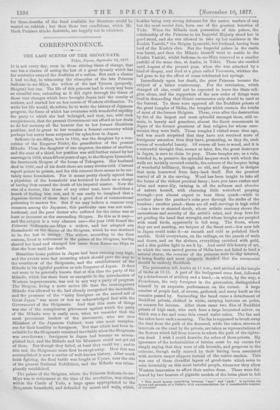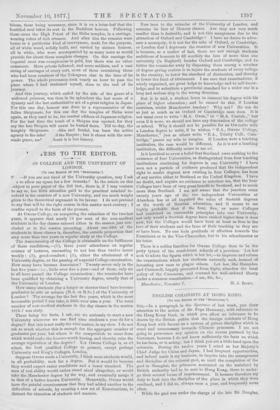CORRESPONDENCE.
THE LAST SCENES OF THE SHOGUNATE.
Tokio, Japan, September 13, 1877.
IT is not every day, even in these stirring times of change, that one has a chance of seeing the last of a great dynasty which has for centuries swayed the destinies of a nation. But such a chance I had to-day, in witnessing the obsequies of the late Princess Seikuan-in-no-Miya, the widow of the last Tycoon (properly, Shogun) but one. The life of this princess had in every way been an eventful one, extending as it did right through the times of those vast changes which have brought Japan into the comity of nations, and started her on her course of Western civilisation. To write her life would, therefore, be to write the history of Japanese progress, the force of which has overcome with wonderful rapidity the party to which she had belonged, and that, too, with such completeness, that the present Government can afford at her death to do her memory all the honour due to her former illustrious position, and to grant to her remains a funeral ceremony which perhaps has never been surpassed for splendour in Japan.
Seikuan-in-no-Miya, born in 1844, was the daughter by a con- cubine of the Emperor Ninkii, the grandfather of the present ,Mikado. Thus, the daughter of one emperor, the sister of another, and the aunt of a third, her position was still further raised by her marriage in 1859, when fifteen years of age, to the Shogun lyemocbi, the fourteenth Shogun of the house of Tokugawa. Her husband died in 1866, and of his death there are many stories told. Current report points to poison, and for this rumour there seems to be cer- tainly some foundation. For it seems pretty clearly agreed that a physician of the household was tortured to death on a charge of having thus caused the death of his imperial master. Now the sins of a doctor, like those of any other man, have doubtless a knack of finding him out, and it can easily be imagined that a Japanese doctor of those days had a good deal of unintentional poisoning to answer for. But if we may believe a rumour very common among the Japanese, this particular case was not unin- tentional, and the poor doctor who suffered for the crime was at least as innocent as the succeeding Shogun. Be this as it may— and the subject is a very obscure one—the year 1866 found the Princess Seikuanin-no-Miya a widow, and her adopted son Stotsubashi on the throne of the ShOguns, which he was destined to be the last to occupy. The widow, according to the then custom, lived in retirement in the palace of the Shoguns, having shaved her head and changed her name from Katsu-no-Miya to that she bore until her death.
Meantime home politics in Japan had been running very high, and the events were fast occurring which should pave the way to the overthrow of the Shogunate, and the establishment of the Mikado in his rightful position as sole Emperor of Japan. It does not seem to be generally known that at this time the party of the Mikado, which has since been so energetic in the introduction of Western improvements, was not in any way a party of progress. The Shogun, living a more active life than the contemporary Mikado was allowed to do, had already recognised the inevitable, and the presence of the 4‘ hairy foreigner on the sacred soil of Great Japan " was more or less an acknowledged fact with the Government of the Shogunate. And that this state of things was one of the conspicuous grievances against which the party of the Mikado rose is easily seen, when we consider that the most prominent leaders of the movement, who are now Ministers of the Japanese Cabinet, were also most conspicu- ous for their hostility to foreigners. But that which had been in- evitable for the Shogunate remained inevitable when the Shogunate was overthrown ; foreigners in Japan had become an accom- plished fact, and the Mikado and his Ministers could not get rid of them. But though they failed, at least they could try ; and to this end, the Slaigunate must first be swept away. How this was accomplished is now a matter of well-known history. After much brisk fighting, the final battle was fought at Uyeno, near the site of the present National Exhibition, and the Mikado was trium- phantly established.
The palace of the Shoguns, where the Princess Seikuan-in-no- Miya was in retirement at the time of the revolution, was situate within the Castle of Yedo, a large space appropriated to the ShOgunate household, and defended by moats and walls, which, besides being very strong defences for the native warfare of any but the most recent date, form one of the greatest beauties of Yedo. When the Mikado took possession of this palace, the relationship of the Princess to his Imperial Majesty stood her in good stead, and she was allowed to take up her residence in the Kiishiu Yashiki,* the ShOgun Iyemochi, her husband, having been lord of the Kiishiu clan. But the Imperial palace in the castle was burnt, and then the Mikado himself went to reside in the Kiishiu Yashiki, whilst Seikuan-in-no-Miya removed to a smaller yashiki of the same clan, at Asabu, in Tokio. There she resided until August of the present year, when she was attacked by a kind of dropsy, and died at a place called TOnosawa, whither she had gone to try the effect of some celebrated hot springs.
Immediately upon her death, the poor Princess became the subject of a bitter controversy. For the revolution, which changed all else, could not be expected to leave the State reli- gion alone, and the supporters of the new order of things were loud in demanding that ShintO ceremonies only should be used at the funeral. To these were opposed all the Buddhist priests of the great temples of Shiba, the temples which contain the tombs of most of the former Shoguns. These, even after the destruction by fire of the largest and most splendid amongst them, still re- main, in beauty and grandeur, almost the finest monuments in Japan of the former greatness of that religion for whose cere- monies they were built. These temples I visited some time ago, and was much surprised that they have not received more of foreigners' attention than they have, presenting, as they do, such scenes of wonderful beauty. Of course all here is wood, and it is a sorrowful thought that, sooner or later, fire, the great destroyer in Japan, is sure to claim its prey. These temples are, as a rule, boarded in, to preserve the splendid lacquer-work with which the walls are lavishly covered outside, the colours of the lacquer being of wonderful brilliancy, though so old, and disposed in designs that seem borrowed from fairy-land itself. But the greatest marvel of all is the carving. Wood has been taught to take all the forms of the richest poetical fancy ; here you have rushes and lotus and water-lily, twining in all the softness and abandon of nature herself, with charming little waterfowl peeping through—you almost expect to hear them quack—while in another place the panther's cubs peer through the stalks of the bamboo ; another panel—these are all wall-carvings in high relief —has a tree or stunted shrub, whose artistic anatomy shows the earnestness and severity of the artist's mind, and deep love for art guiding the hand that wrought, and whose boughs are peopled with small birds, apparently in full song. The floors, where they are not matting, are lacquer of the finest sort—few now left in Japan could make it—as smooth and cold as polished black marble. Gold everywhere, on the ceilings, on the panels of walls and doors, and on the shrines, everything enriched with gold, and a dim golden light to see it by. And amid this beauty of art, to which the once sacred groves of Shiba have not failed to lend a natural charm, the remains of the princess were to-day interred, it being finally and most properly decided that the ceremonial should be entirely Buddhist.
The procession left Asabu at 11 a.m., and arrived at the temple of Shiba at 12.15. A part of the bodyguard came first, followed by a detachment of artillery and a band,—in which, by the way, a Frenchman, the only foreigner in the procession, distinguished himself by an exquisite performance on the cornet. A large number of people had, of course, gathered, and many knelt as the remains passed by. Succeeding the band came a detachment of Buddhist priests, clothed in white, carrying lanterns on poles, or censers for incense. After these came two files of Buddhist priests of high rank, who each bore a large lacquered salver, on which was a fan and some thin round wafer-cakes. The fan and the cakes have each a meaning. The fan is supposed to brush away the dust from the path of the deceased, while the cakes, strewn at intervals on the road by the priests, are taken as representations of the flowers which fall from heaven to adorn the path of the righte- ous dead. I wish I could describe the robes of these priests. My ignorance of the technicalities of fabrics must be my excuse for simply saying that they were of silk brocade, and gorgeous in the extreme, though sadly marred by their having been associated with modern carpet slippers instead of the native sandals. This was one of those dreadful lapses of good-taste which seem to seize invariably on this most tasteful people, whenever they allow Western innovation to affect their native dress. These were fol- lowed by two bearers of gigantic models of the lotus plant in full
* This word means something between "seat " and "park." It includes the house and grounds of a Daimio, with accommodation for a considerable number of retainers. bloom, these being necessary, since it is on a lotus-leaf that the beatified soul takes its seat in the Buddhist heaven. Following these came the High Priest of the Shiba temples, in a carriage, wearing robes of rich crimson. Aud after him the remains were borne in a particular kind of conveyance, made for the purpose, all of white wood, solidly built, and carried by sixteen bearers, all in white, who were accompanied by as many more as would provide for about three complete changes. On this carriage the imperial crest was conspicuous in gold, but there was no other trnament. More priests followed, and more soldiers, and a vast string of carriages of every sort, most of them containing those who had been retainers of the Tokugawa clan in the time of its power. The whole procession took nearly an hour to pass the place where I had stationed myself, close to the end of its journey.
And this journey, which ended by the side of the grave of a widowed princess, was thus in its splendour the last scene of a dynasty and the last authoritative act of a great religion in Japan. For this one day, honour was done to a representative of the fallen ShOgunate, for this one day the temples of Shiba were again, as they used to be, the central edifices of Japanese religion. For the last time the tomb of a Shogun was opened, for they say the late Shogun will never be buried there. Till to-day, the 'haughty Shogune.te - :like and feudal, has been the active agency in the mine Al the Empire ; but it closes with the new-
made grave, an Jforth it is but history.







































 Previous page
Previous page